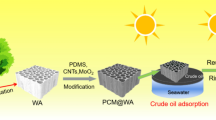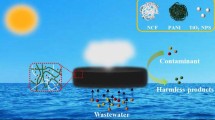Abstract
Solar thermal interfacial evaporation is a cutting-edge method that has been recently developed to produce fresh water using sunlight. Herein, an incredibly robust, cost-effective and highly durable polystyrene-activated carbon-polyurethane foam (PSC) composite fabricated as an efficient solar thermal evaporator (STE). It offers a high evaporation rate of 1.70 kg m− 2 h− 1 with excellent photothermal efficiency under one sun illumination (1 kW m− 2). Due to its porous nature, PSC-STE has excellent dye water, salt water, and highly dense muddy water filtering ability, confirmed using UV-visible spectroscopy. A 0.16 m2 solar still was constructed to show the device’s performance under natural solar irradiation conditions. With natural solar irradiation of less than 0.8 kW m− 2, the solar still generates approximately 280–340 ml of fresh water within 6–7 h a day. Moreover, the device shows excellent purification properties of highly contaminated water of 710 ppm to 12 ppm. As a result, the non-decomposable waste polystyrene, converted into this valuable, cost-effective, and highly stable PSC solar-driven evaporator, can be employed as a long-term approach for highly clean water production.








Similar content being viewed by others
References
Tao P, Ni G, Song C et al (2018) Solar-driven interfacial evaporation. Nat Energy 3:1031–1041. https://doi.org/10.1038/s41560-018-0260-7
Zhang J, Li Z, Meng T et al (2022) Monolithic all-weather solar-thermal interfacial membrane evaporator. Chem Eng J 450:137893. https://doi.org/10.1016/j.cej.2022.137893
Shen H, Zheng Z, Liu H, Wang X (2022) A solar-powered interfacial evaporation system based on MoS2-decorated magnetic phase-change microcapsules for sustainable seawater desalination. J Mater Chem A 10:25509–25526. https://doi.org/10.1039/D2TA07353F
Li Z, Wang C, Su J et al (2019) Fast-growing field of Interfacial Solar Steam Generation: Evolutional materials, Engineered architectures, and synergistic applications. Sol RRL 3:1–19. https://doi.org/10.1002/solr.201800206
Han X, Besteiro LV, Koh CSL et al (2021) Intensifying heat using MOF-Isolated graphene for solar-driven seawater desalination at 98% solar-to-thermal efficiency. Adv Funct Mater 31:1–7. https://doi.org/10.1002/adfm.202008904
Tang S, Lu X, Geng P et al (2023) A non-covalent supramolecular dual-network polyelectrolyte evaporator based on direct-ink-writing for stable solar thermal evaporation. Mater Adv 4:223–230. https://doi.org/10.1039/D2MA00927G
Zhu L, Gao M, Peh CKN, Ho GW (2019) Recent progress in solar-driven interfacial water evaporation: Advanced designs and applications. Nano Energy 57:507–518. https://doi.org/10.1016/j.nanoen.2018.12.046
Lal S, Batabyal SK (2022) Activated carbon-cement composite coated polyurethane foam as a cost-efficient solar steam generator. J Clean Prod 379:134302. https://doi.org/10.1016/j.jclepro.2022.134302
Shi L, Wang X, Hu Y et al (2020) Solar-thermal conversion and steam generation: a review. Appl Therm Eng 179:115691. https://doi.org/10.1016/j.applthermaleng.2020.115691
Tawalbeh M, Qalyoubi L, Al-Othman A et al (2023) Insights on the development of enhanced antifouling reverse osmosis membranes: industrial applications and challenges. Desalination 553:116460. https://doi.org/10.1016/j.desal.2023.116460
Arana Juve J-M, Christensen FMS, Wang Y, Wei Z (2022) Electrodialysis for metal removal and recovery: a review. Chem Eng J 435:134857. https://doi.org/10.1016/j.cej.2022.134857
Strathmann H (1995) Chap. 6 Electrodialysis and related processes. In: Noble RD, Stern SABT-MS and T (eds) Membrane separations technology. Elsevier, pp 213–281
Moossa B, Trivedi P, Saleem H, Zaidi SJ (2022) Desalination in the GCC countries- a review. J Clean Prod 357:131717. https://doi.org/10.1016/j.jclepro.2022.131717
Shalaby SM, Kabeel AE, Abosheiasha HF et al (2022) Membrane distillation driven by solar energy: a review. J Clean Prod 366:132949. https://doi.org/10.1016/j.jclepro.2022.132949
Irshad MS, Hao Y, Arshad N et al (2023) Highly charged solar evaporator toward sustainable energy transition for in-situ freshwater & power generation. Chem Eng J 458. https://doi.org/10.1016/j.cej.2023.141431
Irshad MS, Arshad N, Zhang J et al (2023) Wormlike Perovskite Oxide coupled with phase-change material for all-Weather Solar Evaporation and Thermal Storage Applications. Adv Energy Sustain Res 4:1–13. https://doi.org/10.1002/aesr.202200158
Irshad MS, Wang X, Abbas A et al (2021) Salt-resistant carbon dots modified solar steam system enhanced by chemical advection. Carbon N Y 176:313–326. https://doi.org/10.1016/j.carbon.2021.01.140
Neumann O, Urban AS, Day J et al (2013) Solar Vapor Generation enabled by Nanoparticles. ACS Nano 7:42–49. https://doi.org/10.1021/nn304948h
Ni G, Miljkovic N, Ghasemi H et al (2015) Volumetric solar heating of nanofluids for direct vapor generation. Nano Energy 17:290–301. https://doi.org/10.1016/j.nanoen.2015.08.021
Luo X, Shi J, Zhao C et al (2021) The energy efficiency of interfacial solar desalination. Appl Energy 302:117581. https://doi.org/10.1016/j.apenergy.2021.117581
Shi C, Zhang X, Nilghaz A et al (2023) Large-scale production of spent coffee ground-based photothermal materials for high-efficiency solar-driven interfacial evaporation. Chem Eng J 455:140361. https://doi.org/10.1016/j.cej.2022.140361
Soo Joo B, Soo Kim I, Ki Han I et al (2022) Plasmonic silicon nanowires for enhanced heat localization and interfacial solar steam generation. Appl Surf Sci 583:152563. https://doi.org/10.1016/j.apsusc.2022.152563
Wu J, Li X, Zhang T et al (2022) All-weather-available electrothermal and solar–thermal wood-derived porous carbon-based steam generators for highly efficient water purification. Mater Chem Front 6:306–315. https://doi.org/10.1039/D1QM01544C
Yu S, Gu Y, Chao X et al (2023) Recent advances in interfacial solar vapor generation: clean water production and beyond. J Mater Chem A 11:5978–6015. https://doi.org/10.1039/D2TA10083E
Fillet R, Nicolas V, Fierro V, Celzard A (2021) A review of natural materials for solar evaporation. Sol Energy Mater Sol Cells 219:110814. https://doi.org/10.1016/j.solmat.2020.110814
Shi L, Wang Y, Zhang L, Wang P (2017) Rational design of a bi-layered reduced graphene oxide film on polystyrene foam for solar-driven interfacial water evaporation. J Mater Chem A 5:16212–16219. https://doi.org/10.1039/c6ta09810j
Wang G, Fu Y, Ma X et al (2017) Reusable reduced graphene oxide based double-layer system modified by polyethylenimine for solar steam generation. Carbon N Y 114:117–124. https://doi.org/10.1016/j.carbon.2016.11.071
Ghasemi H, Ni G, Marconnet AM et al (2014) Solar steam generation by heat localization. Nat Commun 5:1–7. https://doi.org/10.1038/ncomms5449
Lal S, Batabyal SK (2023) Ambient evaporation-induced electricity generation in activated carbon-water interfaced three-dimensional hydrovoltaic device. J Power Sources 568:232951. https://doi.org/10.1016/j.jpowsour.2023.232951
Chen W, Hao H, Hughes D et al (2015) Static and dynamic mechanical properties of expanded polystyrene. Mater Des 69:170–180. https://doi.org/10.1016/j.matdes.2014.12.024
Taylor P, Maharana T, Negi YS, Mohanty B (2007) Polymer-Plastics Technology and Engineering Review article. Recycling of Polystyrene Review Article: Recycling of Polystyrene 37–41. https://doi.org/10.1080/03602550701273963
Uttaravalli AN, Dinda S, Gidla BR (2020) Scientific and engineering aspects of potential applications of post-consumer (waste) expanded polystyrene: a review. Process Saf Environ Prot 137:140–148. https://doi.org/10.1016/j.psep.2020.02.023
Dement’ev KI, Bedenko SP, Minina YD et al (2023) Catalytic Pyrolysis of Polystyrene Waste in Hydrocarbon Medium. Polymers (Basel). 15
Kim DH, Jeong JH, Woo HC, Kim MH (2021) Synthesis of highly porous polymer microspheres with interconnected open pores for catalytic microreactors. Chem Eng J 420:127628. https://doi.org/10.1016/j.cej.2020.127628
Kim DH, Jeong JH, Woo H-C, Kim MH (2021) Synthesis of highly porous polymer microspheres with interconnected open pores for catalytic microreactors. Chem Eng J 420:127628. https://doi.org/10.1016/j.cej.2020.127628
Farma R, Fatjrin D, Awitdrus, Deraman M (2017) Physical properties of activated carbon from fibers of oil palm empty fruit bunches by microwave assisted potassium hydroxide activation. AIP Conf Proc 1801:40001. https://doi.org/10.1063/1.4973090
Daud FN, Ahmad A, Haji Badri K (2014) An investigation on the properties of Palm-based polyurethane solid polymer Electrolyte. Int J Polym Sci 2014:326716. https://doi.org/10.1155/2014/326716
Chavan V, Anandraj J, Joshi GM, Cuberes MT (2017) Structure, morphology and electrical properties of graphene oxide: CuBiS reinforced polystyrene hybrid nanocomposites. J Mater Sci Mater Electron 28:16415–16425. https://doi.org/10.1007/s10854-017-7552-8
Fang J, Xuan Y, Li Q (2010) Preparation of polystyrene spheres in different particle sizes and assembly of the PS colloidal crystals. Sci China Technol Sci 53:3088–3093. https://doi.org/10.1007/s11431-010-4110-5
Saka C BET, TG–DTG, FT-IR (2012) SEM, iodine number analysis and preparation of activated carbon from acorn shell by chemical activation with ZnCl2. J Anal Appl Pyrolysis 95:21–24. https://doi.org/10.1016/j.jaap.2011.12.020
Chafidz A, Astuti W, Augustia V et al (2018) Removal of methyl violet dye via adsorption using activated carbon prepared from Randu sawdust (Ceiba pentandra). IOP Conf Ser Earth Environ Sci 167. https://doi.org/10.1088/1755-1315/167/1/012013
Mohammadi A, Barikani M, Barmar M (2014) Synthesis and investigation of thermal and mechanical properties of in situ prepared biocompatible Fe3O4/polyurethane elastomer nanocomposites. Polym Bull. https://doi.org/10.1007/s00289-014-1268-1
Donoso JP, Tambelli CE, Silva I (2010) Nuclear magnetic resonance study of Hydrated Bentonite. Nuclear Magn Reson Study Hydrated Bentonite. https://doi.org/10.1080/15421401003723219
Hachani S, Wis A, Necira Z et al (2018) Effects of Magnesia Incorporation on Properties of Polystyrene/Magnesia Composites. Acta Chim Slov 65. https://doi.org/10.17344/acsi.2018.4305
Liu F, Gu Y, Hu Y et al (2023) Freestanding ultrathin precisely structured hierarchical porous Carbon Blackbody Film for efficient solar interfacial evaporation. Sol RRL 7:1–10. https://doi.org/10.1002/solr.202200803
Xu C, Gao M, Yu X et al (2023) Fibrous aerogels with tunable superwettability for high-performance solar-driven interfacial evaporation. Nano-Micro Lett 15:1–18. https://doi.org/10.1007/s40820-023-01034-4
Chang MJ, Zhu WY, Wang H et al (2023) Patterned nanofibrous membrane via hot-pressing for enhanced solar thermal evaporation. Mater Chem Phys 302:127727. https://doi.org/10.1016/j.matchemphys.2023.127727
Zhang X, Yan Y, Li N et al (2023) A robust and 3D-printed solar evaporator based on naturally occurring molecules. Sci Bull 68:203–213. https://doi.org/10.1016/j.scib.2023.01.017
Cong M, Wang F, Zhang Y et al (2023) An array structure of polydopamine/wood solar interfacial evaporator for high-efficiency water generation and desalination. Sol Energy Mater Sol Cells 249:112052. https://doi.org/10.1016/j.solmat.2022.112052
Wu YG, Xue CH, Guo XJ et al (2023) Highly efficient solar-driven water evaporation through a cotton fabric evaporator with wettability gradient. Chem Eng J 471:144313. https://doi.org/10.1016/j.cej.2023.144313
Lal S, Batabyal SK (2022) Potato-based microporous carbon cake: solar radiation induced water treatment. J Environ Chem Eng 10:108502. https://doi.org/10.1016/j.jece.2022.108502
Irshad MS, Wang X, Arshad N et al (2022) Bifunctional in situ polymerized nanocomposites for convective solar desalination and enhanced photo-thermoelectric power generation. Environ Sci Nano 1685–1698. https://doi.org/10.1039/d1en01018b
Irshad MS, Wang X, Abbasi MS et al (2021) Semiconductive, flexible MnO2NWs/Chitosan hydrogels for efficient solar steam generation. ACS Sustain Chem Eng 9:3887–3900. https://doi.org/10.1021/acssuschemeng.0c08981
Olszak N What is the pH of DI Water? | Complete Water Solutions. https://complete-water.com/resources/what-is-the-ph-of-di-water
Young E Don’t drink a drop until you know the TDS in your water | RO-System.org. https://www.ayurtimes.com/minimum-maximum-acceptable-tds-level-drinking-water/
Author information
Authors and Affiliations
Contributions
G.P. and S.L. performed the experiment, analyzed the data, and wrote the original draft of the main manuscript. S.K.B. designed the research problem and methododlogy, supervised the project and edited the final version of the manuscript.
Corresponding author
Ethics declarations
Competing Interests
The authors declare no competing interests.
Additional information
Publisher’s Note
Springer Nature remains neutral with regard to jurisdictional claims in published maps and institutional affiliations.
Electronic Supplementary Material
Below is the link to the electronic supplementary material.
Rights and permissions
Springer Nature or its licensor (e.g. a society or other partner) holds exclusive rights to this article under a publishing agreement with the author(s) or other rightsholder(s); author self-archiving of the accepted manuscript version of this article is solely governed by the terms of such publishing agreement and applicable law.
About this article
Cite this article
Pisharody, G., Lal, S. & Batabyal, S.K. Turning Thermocol Waste into a Highly Efficient Carbon Composite as an Interfacial Solar Thermal Evaporator. J Polym Environ (2024). https://doi.org/10.1007/s10924-023-03181-6
Accepted:
Published:
DOI: https://doi.org/10.1007/s10924-023-03181-6




